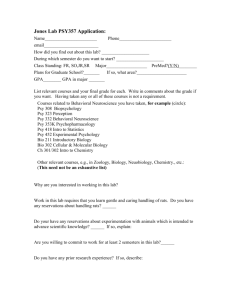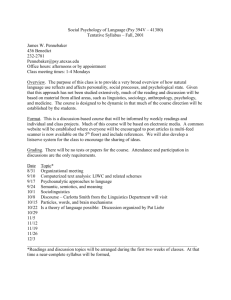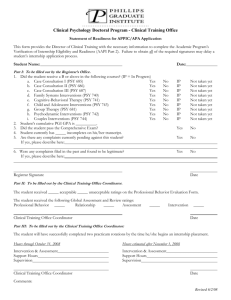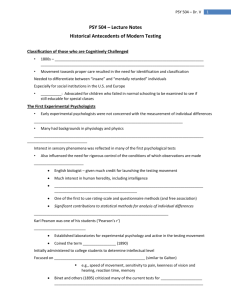9 - Color
advertisement
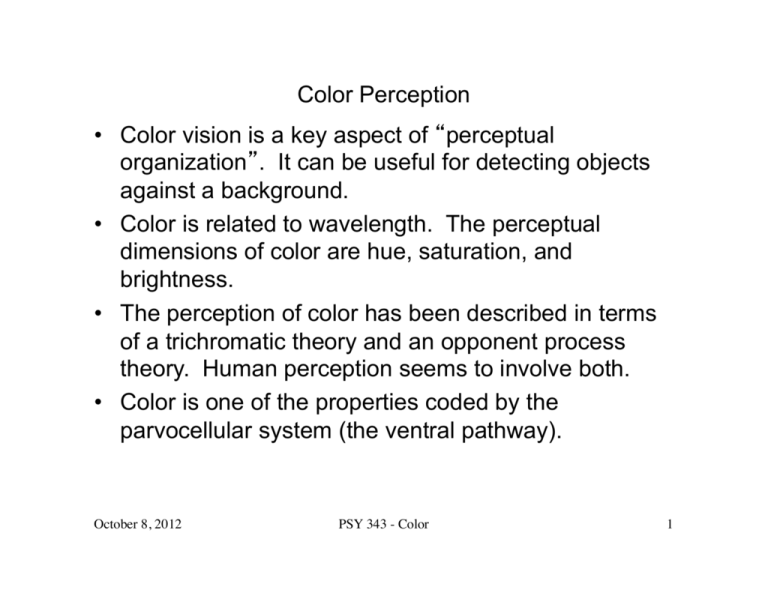
Color Perception • Color vision is a key aspect of perceptual organization . It can be useful for detecting objects against a background. • Color is related to wavelength. The perceptual dimensions of color are hue, saturation, and brightness. • The perception of color has been described in terms of a trichromatic theory and an opponent process theory. Human perception seems to involve both. • Color is one of the properties coded by the parvocellular system (the ventral pathway). October 8, 2012 PSY 343 - Color 1 Terms and Basic Colors Achromatic refers to black, white, and the grey scale in between. The achromatic colors result from a mixture of all wavelengths. Chromatic color refers to blue, red, yellow, green, etc. We also refer to chromatic color as hue. As white is mixed in with a hue, it appears washed-out. The hue is still the same, but the experience of color changes. This is the dimension of saturation. Pink and red are color terms that reflect a change in saturation. As the intensity of any wavelength or set of wavelengths is changed, we experience a change in brightness. October 8, 2012 PSY 343 - Color 2 The Color Wheel If we arrange hues so that similar colors are next to one another, we get a circular figure - the color wheel. red blue yellow green October 8, 2012 PSY 343 - Color 3 Relative light intensity Color is Reflected Light Different light sources are composed of different relative intensities of the wavelengths in the spectrum. tungsten sunlight 400 October 8, 2012 600 500 Wavelength (nm) PSY 343 - Color 700 4 Hue versus Wavelength The table below shows how the basic colors correspond to wavelengths. Reflected Wavelengths Perceived color short medium long medium and long a little medium and long short and long short, medium and long October 8, 2012 PSY 343 - Color blue green red yellow orange purple white 5 Mixing Pigment Mixing paint is subtractive color mixing. The wavelengths reflected from the mixture are only those also reflected by each component pigment. wavelengths blue green yellow orange red Blue Paint Reflects Reflects Absorbs Absorbs Absorbs all some all all (most)all Yellow Paint Absorbs Reflects Reflects Absorbs Absorbs all some all all all October 8, 2012 PSY 343 - Color 6 Trichromatic Theory From color matching experiments, we know that a human can match any color by mixing (varying the intensities) of three suitable primary colors. For example, given control over the intensities of lights of 420, 560, and 640 nm, the observer can match the color of any arbitrary mixture of wavelengths. Because humans require three primaries, our color vision is known as trichromatic. If given only two primaries, there are colors that can not be matched. October 8, 2012 PSY 343 - Color 7 Trichromatic Theory - 2 Young and Helmholtz proposed that color vision was mediated by three different receptors that absorbed light of different wavelengths to different degrees. Color perception was proposed to be based on the pattern of responses from the three receptors. Thus, humans could match any color by mixing three suitable primaries. This theory, based on psychophysical data, preceded the discovery of three different types of cones by over a century. October 8, 2012 PSY 343 - Color 8 Trichromatic Theory - 3 Based on trichromatic theory, we expect to find three types of dichromatic color-blindness. One would correspond to the loss of each of the three different receptors. There are three forms of dichromatism: protanopia, deuteranopia, and tritanopia. However, there are also data that trichromatic theory has a hard time explaining. October 8, 2012 PSY 343 - Color 9 Opponent Process Theory What are the basic colors? Is yellow any less basic than red, green, and blue? When you stare at a color, then look at a white area, you see an afterimage. Blue and yellow are paired (stare at blue, see a yellow afterimage) and vice versa. Similarly, red and green are paired. Why? To account for observations like these, Hering proposed the opponent process theory of color vision. October 8, 2012 PSY 343 - Color 10 Opponent Process - 2 black - white + blue - yellow + red - green + Hering proposed that colors are signaled by three mechanisms that respond in opposite ways to the two colors in their pair. While Hering s proposal does not describe the receptors in the retina, it does have a relation to the physiology of color vision. October 8, 2012 PSY 343 - Color 11 Physiology of Color Vision Trichromatic theory describes the operation of the receptors (cones) in the retina. There are three different cones that have different spectral absorption curves. This is the reason why it takes three primaries for a human to mix and match any other color. This leads to metamers - Different combinations of wavelengths that appear the same because they stimulate the receptors in the same ratios. For example, it is possible to adjust the intensities of 530 nm and 620 nm lights so that when mixed the result appears identical to a single, 580 nm light. October 8, 2012 PSY 343 - Color 12 Three Cones - Spectral Absorption high short medium sensitivity long low 400 October 8, 2012 500 600 Wavelength PSY 343 - Color 700 13 Opponent Processes Physiology In the ganglion cells of goldfish, the cells are color sensitive. They behave in an opponent fashion where a cell may respond positively to blue but be inhibited (fire less than its spontaneous rate) by yellow. The colors blue and yellow and red and green are always paired. In the LGN of the monkey, the color sensitive cells in the parvocellular system show the same property (see next slide). October 8, 2012 PSY 343 - Color 14 October 8, 2012 PSY 343 - Color 15 Opponent Process Physiology - 2 In the cortex of the monkey we find double opponent cells. In the center, this cell might be excited by red and inhibited by green. In the surround, the opposite pattern is found with excitation by green and inhibition by red. October 8, 2012 -R +G +R -G PSY 343 - Color 16 Opponent Process Physiology - 3 In the striate cortex, if we look within a hypercolumn, we discover that all of the color sensitive cells in a hypercolumn respond to the same color pair and an adjacent hypercolumn would code the other color pair. How does the trichromatic coding of color at the receptor get converted to an opponent color scheme? Why have an opponent scheme? October 8, 2012 PSY 343 - Color 17 Wiring in Color Vision B+ Y- October 8, 2012 R+ G- PSY 343 - Color 18 Properties of the Hybrid Model 1. Color mixing would depend upon three primaries. 2. Yellow/Blue and Red/Green exist in opponent pairs. 3. Three types of dichromatic color blindness are predicted - Two are red/green and one is blue/yellow. 4. Long wavelength reds should look a bit yellow. An optimal red is the result of mixing a small amount of short wavelength with the predominantly long wavelength. 5. The neural coding reduces the overlap in color by sharpening the differences between adjacent cone spectral absorption (see next slide). October 8, 2012 PSY 343 - Color 19 October 8, 2012 PSY 343 - Color 20 Color Blindness 1. Monochromatism. Rod only vision. Hereditary and occurs in about 10 in 1,000,000 people. 2. Dichromatism - Three types corresponding to loss of long wavelength cone (protanopia), medium wavelength cone (deuteranopia) and [we think] the short wavelength cone (tritanopia). Sex-linked, inherited disorder (based on X chromosome). October 8, 2012 PSY 343 - Color 21 Dichromatism Protanopia and Deuteranopia are two forms of red/green colorblindness. Each occurs in about 100 in 10,000 males (1%) and 2 in 10,000 females (.02%). What colors does a dichromat see? Rarely, a human is trichromatic in one eye and dichromatic in the other. Based on their description, reds and greens that look normal in the trichromatic eye look beige (yellowish) in the dichromatic eye. For both protanopes and deuteranopes, there is a neutral point between blue and yellow. October 8, 2012 PSY 343 - Color 22 October 8, 2012 PSY 343 - Color 23 Dichromatism - 2 Tritanopia is blue/yellow color blindness. It is very rare (about 2 in 100,000 males and less than 1 in 100,000 females). It is thought to represent the loss of the short wavelength cone. October 8, 2012 PSY 343 - Color 24 Color Vision Summary • Color vision is both trichromatic at the receptors and opponent process at the LGN and later. • Color is coded in a separate set of neurons and is part of the parvocellular system and the ventral pathway. • Dichromatism is the result of the loss of one type of cone, but results in the loss of a pair of colors. • Color is a synthetic percept. It is a creation of the brain. Color perception is a private, mental experience. October 8, 2012 PSY 343 - Color 25 Perceptual Constancy • As you move, or objects move, or lighting changes, the image on the retina (proximal stimulus) changes. However, perception is of a constant distal stimulus. This is perceptual constancy. • In vision, this occurs for color, lightness, shape and size. • Knowledge has only a limited effect on perceptual constancy. October 8, 2012 PSY 343 - Color 26 Color Constancy When the spectrum of light that falls on an object changes, color perception is only slightly altered. Incandescent light has more of the red end of the spectrum and less of the blue than sunlight. However, colors look basically the same under the two. This is color constancy. In comparison, if the same photographic film is used with both sunlight and incandescent light, colors that look normal under sunlight will all look orangish/reddish under incandescent. The objects being photographed have not changed. Our perception seems to follow this distal stimulus. How? October 8, 2012 PSY 343 - Color 27 Color Constancy - 2 Factors affecting color constancy include: 1) Chromatic adaptation 2) Effects of surrounding areas 3) Memory for color October 8, 2012 PSY 343 - Color 28 Chromatic adaptation In chromatic adaptation, the cones adjust to the ambient amount of reflected light at each wavelength. Under incandescent light, the overall amount of long wavelengths (the red end of the spectrum) reaching the eye is higher. The long wavelength cones bleach out more (more of their photo pigment is used up). This makes the eye less sensitive to the long wavelengths. So, the balance among the wavelengths in their influence on perception is (partly) restored and your perception of color is unchanged. October 8, 2012 PSY 343 - Color 29 Chromatic adaptation experiment An observer views a patch of paper normally seen as green under the conditions below. When the light illuminating the patch does not match the observer s chromatic adaptation, color constancy disappears. Condition Baseline Light on Observer Paper Adaptation Perception white white green No chromatic red adaptation white yellow (shifted toward red) Chromatic adaptation red Green (slightly shifted to red) October 8, 2012 red PSY 343 - Color 30 Surroundings When color constancy is tested on a plain white background, it works less well. Here, observers report more of an apparent change in color. When color constancy is tested on a background of other, varied colors, then the object being tested appears the same color. October 8, 2012 PSY 343 - Color 31 Memory Color constancy can be demonstrated for meaningless stimuli that can have any color, such as a square. If objects that have a consistent color are used in color matching task (e.g. heart and apple are characteristically red), then the color that an observer matches them to will tend toward their characteristic color. When an observer matches the background color to the object color of a red apple, heart, mushroom or bell, the background color chosen is redder for the heart or apple. October 8, 2012 PSY 343 - Color 32 Color constancy physiology Simultaneously record from neurons in V1 and V4 that respond to +G-R in same receptive field. For green square illuminated with white light, both V1 and V4 neurons fire. For the same green square illuminated with reddish light, V1 neuron does not fire, but V4 neuron does. Thus, V1 neuron responds to wavelength (proximal stimulus) but V4 neuron responds to color (distal stimulus). V4 neuron probably gets input from adjacent areas (influence of surroundings). October 8, 2012 PSY 343 - Color 33 Lightness Constancy On a sunny day with snow cover in winter, a black surface outdoors will reflect more total light than a light grey or white surface does indoors. However, the outdoors black looks black and the indoors white looks white. How? The starting point for our answer is the same as with color. Pigment bleaching in the retina reduces sensitivity and objects are compared to their surroundings. October 8, 2012 PSY 343 - Color 34 Lightness constancy - Ratios The effect of the surroundings is to provide an invariant (something that does not change with changes in illumination) for lightness - the ratio of reflectance across different, adjacent areas. In the disks below, the ratio between center and surround is the same and the relative lightness of the two sets will look the same. October 8, 2012 1000 100 100 10 PSY 343 - Color 35 Lightness Ratios - 2 In this display, the two small squares look to be about the same lightness. This is because their ratios to their backgrounds are the same. The two small squares are quite different. October 8, 2012 PSY 343 - Color 36 Lightness Ratios - 3 Here are the two small squares on the same background. They no longer appear the same. October 8, 2012 PSY 343 - Color 37 Lightness constancy experiment Gelb had an observer view a disk that was black. The observer looked through a viewport. The interior was dimly illuminated. Under these conditions, the disk looked black. Next, a narrow spotlight, unseen by the observer, illuminates only the disk. Now, the disk looks white. Finally, a small white rod is positioned in front of the illuminated disk, now the disk looks black. As the rod is removed from view, the disk flips back to white. Reintroduce the white rod, the disk looks black. The knowledge of the observer has virtually no influence on lightness perception here. October 8, 2012 PSY 343 - Color 38 Lightness constancy experiment - 2 black disk dim illumination spot light observer October 8, 2012 PSY 343 - Color 39 Lightness - Interpretation The perception of lightness is altered by the interpretation of the surface. This includes effects of depth and shadows. Depth - a surface in depth can be illuminated or in shadow. If the apparent depth changes, then the apparent lightness of the surfaces changes. light October 8, 2012 A PSY 343 - Color B 40 Lightness - Interpretation 2 In display A, the center edge appears to project toward the viewer. The card appears uniform even though the left side is in shadow and reflecting less light. In display B, the same card appears to have the center edge further away (like an open book). The left side then must be in the light and the right in shadow. However, the left side is reflecting less light and the right side is reflecting more. The perceptual interpretation is that the left side is darker and the right side is lighter. October 8, 2012 PSY 343 - Color 41 Lightness - Shadows Areas of a surface in shadow are seen as the same color and lightness as the areas not in shadow. If the edge (penumbra) of the shadow is covered, then the shadowed area appears to be a different lightness. October 8, 2012 PSY 343 - Color 42 Lightness constancy - Physiology Part of the explanation is lateral inhibition. We used this to account for simultaneous contrast, and it works well here for the same situations. For influences of depth and shadows, other factors are needed. The higher cortical mechanisms that produce lightness constancy have not (yet) been discovered. October 8, 2012 PSY 343 - Color 43
